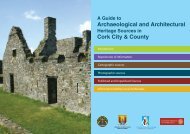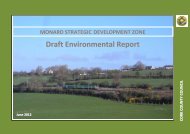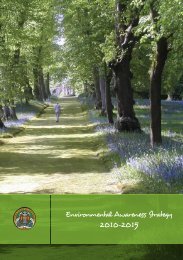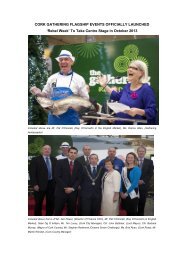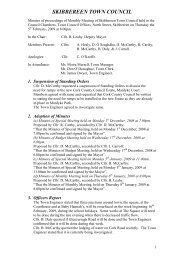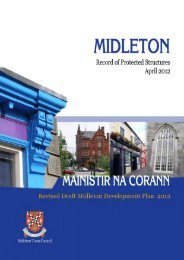Biodiversity in Your School - Cork County Council
Biodiversity in Your School - Cork County Council
Biodiversity in Your School - Cork County Council
You also want an ePaper? Increase the reach of your titles
YUMPU automatically turns print PDFs into web optimized ePapers that Google loves.
Biological DiversityBiological diversity means the variety of life. This <strong>in</strong>cludes plants, animals, thehabitats <strong>in</strong> which they live and all the natural activities that l<strong>in</strong>k these th<strong>in</strong>gstogether. It is not just rare or threatened species but <strong>in</strong>cludes all liv<strong>in</strong>g th<strong>in</strong>gs.Scientists currently estimate that there is 1.9 million different species of liv<strong>in</strong>gth<strong>in</strong>gs on earth but they also th<strong>in</strong>k that this is only a small portion of what is reallyout there.All of us can help <strong>in</strong> keep<strong>in</strong>g all thesespecies safe. We don’t have to travelto exotic forests or high mounta<strong>in</strong>s; wecan act locally to help with theprotection of Ireland’s biodiversity. Byencourag<strong>in</strong>g our local biodiversity <strong>in</strong>school gardens it;• Helps us to learn about and enjoyour Irish wildlife;• Makes all our school visitors andlocal communities aware ofIreland’s important biodiversity. Thiscan help with people’s attitudetowards nature;• Helps to pass on a healthy andfunction<strong>in</strong>g planet to all the futuregenerations, a bio-diversecommunity is a healthy one.Ecosystems, which are the woodlands,lakes and all different habitat typesyou can th<strong>in</strong>k of, support us <strong>in</strong> manyways. They provide services thatprotect us from bad weather eventssuch as floods. The animals that<strong>in</strong>habit them poll<strong>in</strong>ate fruit which wecan then harvest. Insects keep our soilsfertile and full of nutrients so that wecan grow food and other plants.Clean air to breath is ensured by thediversity of trees present <strong>in</strong> manydifferent habitats. All these reasonsand a lot more make biodiversityhighly important to us hav<strong>in</strong>g healthyand happy lives.There are lots of ways to encouragebiodiversity <strong>in</strong> your school garden. Byfollow<strong>in</strong>g some very simple steps youcan create many m<strong>in</strong>i habitats forcommunities of bugs, grow m<strong>in</strong>iwoodlands and meadows, attractmany different types of birds and even<strong>in</strong>vite a mammal or two <strong>in</strong>to yourgarden.<strong>Biodiversity</strong> <strong>in</strong> your school
Mov<strong>in</strong>g <strong>in</strong>...Habitats do not have to be hugeforests or vast deserts. One of the mostimportant contributors to biodiversity <strong>in</strong>woodlands is dead or decay<strong>in</strong>g wood.This can come from fallen or old treesor from piles left after a tree has beenchopped down. These logs or deadwood can provide a m<strong>in</strong>i-habitat forbugs and <strong>in</strong>sects, mosses, fungi anddifferent mushroom types, amphibianssuch as frogs and even some smallmammals like hedgehogs. It is simpleto make a log pile <strong>in</strong> your garden and<strong>in</strong> do<strong>in</strong>g so you create many m<strong>in</strong>ihabitats and places for animals tofeed, rest and eat. Any branches,pieces of wood or cutt<strong>in</strong>gs you havecan be loosely put together <strong>in</strong> a nottoo shady but not too sunny area tocreate the right conditions for plentyof animals to move <strong>in</strong>.Log piles can be important forbiodiversity <strong>in</strong> a number of ways. Notonly do they provide a habitat foranimals but they can provide shelterfor some animals to hide frompredators, provide dark and moistplaces for fungii and plants to grow onand bugs to hide <strong>in</strong>. These provide afood source for birds and mammalssuch as hedgehogs. Log piles and oldwood are most effective when there ismoisture present so bury<strong>in</strong>g some ofthem slightly may <strong>in</strong>crease yourchances of attract<strong>in</strong>g some visitors.Similarly, rock piles and leaf piles canprovide shelter for <strong>in</strong>sects, birds,amphibians and mammals. They can<strong>Biodiversity</strong> <strong>in</strong> your school
also create moist areas by prevent<strong>in</strong>gthe soil surface from dry<strong>in</strong>g out. Sett<strong>in</strong>gthese up is very similar to sett<strong>in</strong>g up alog-pile. Loosely arrange the rocks orleaves where they will be able toreta<strong>in</strong> some moisture, which meansnot <strong>in</strong> direct sunlight!Use bundles of twigs or bound upstraw <strong>in</strong> and around the log or rockpiles. They will provide rest<strong>in</strong>g andhibernation hideaways for <strong>in</strong>sects.Even if you cannot make a log pile,you can make a simple bug box. Youcan just make a small box out ofwood, put some different sized holes <strong>in</strong>the walls to allow the bugs to get <strong>in</strong>, fillit with some old plant stems andmount it on a tree or wall. It will be anideal place for <strong>in</strong>sects such asladybirds.Gett<strong>in</strong>g wetYou could consider build<strong>in</strong>g a smallpond or water feature. You may thenf<strong>in</strong>d <strong>in</strong>sects different from those <strong>in</strong> yourother m<strong>in</strong>i-habitats. You will f<strong>in</strong>d newplants that require certa<strong>in</strong> moistureconditions and maybe even someamphibians.<strong>Biodiversity</strong> <strong>in</strong> your school
Height and LightVegetation <strong>in</strong> the wild is split <strong>in</strong>to anumber of different layers; the flowerlayer is close to the ground with theshrub layer be<strong>in</strong>g higher than that butnot as high as the tree layer. Creat<strong>in</strong>gdifferent plant layers <strong>in</strong> your gardencan encourage biodiversity asdifferent <strong>in</strong>sects and other animalsmay live at different levels.If you don’t have space to havedifferent layers <strong>in</strong> your garden there isno need to worry, as other ways ofattract<strong>in</strong>g different animals can beused. By us<strong>in</strong>g plants of different sizesand growth patterns, you can createareas of light and shade <strong>in</strong> yourgarden. This means that animals thatlike shaded areas may live there aswell as animals that spend more time<strong>in</strong> the open. Try and keep grasses atdifferent heights, some short and somelong. This will create a wider variety ofgrass habitat for <strong>in</strong>sects. You canmake the most of the space you haveby plant<strong>in</strong>g some creep<strong>in</strong>g plants nearwalls or on a trellis - Gardens can goup as well as spread out!Invite birds <strong>in</strong>to your gardenwith these food species(some are good for <strong>in</strong>sects too!)• Bramble • Holly• Crab Apple • Elder• Hawthorn • Broom<strong>Biodiversity</strong> <strong>in</strong> your school
By plant<strong>in</strong>g a wildflower meadow or aborder of flower<strong>in</strong>g plants you mightencourage some butterflies and other<strong>in</strong>sects <strong>in</strong>to your garden. Try to plantspecies that are rich <strong>in</strong> nectar orpollen and you will attract more<strong>in</strong>sects. By plant<strong>in</strong>g species which arerich <strong>in</strong> berries and seeds you willattract more bird species.When plant<strong>in</strong>g, make sure you plantnative species of flowers, grasses,shrubs and trees. Us<strong>in</strong>g native speciesmeans they will be more suited to yoursoils and will prevent the spread ofspecies that are not welcome here.Br<strong>in</strong>g <strong>in</strong> some <strong>in</strong>sectswith these species• Devils-bit Scabious• Common nettle• Thistle species• HoneysuckleEven without plant<strong>in</strong>g you canencourage an <strong>in</strong>crease <strong>in</strong> biodiversityby leav<strong>in</strong>g a ‘wild corner’ <strong>in</strong> yourgarden. By leav<strong>in</strong>g plants grow todifferent sizes without cutt<strong>in</strong>g andmanag<strong>in</strong>g them you leave plenty ofm<strong>in</strong>i habitats for small creatures and<strong>in</strong>sects.Fly<strong>in</strong>g visitsBuild<strong>in</strong>g bird tables or bird boxes willattract the bird species to your gardenalso. To <strong>in</strong>vite <strong>in</strong> some more fly<strong>in</strong>gcreatures you can put up some batboxes. Make sure your bird boxes donot face <strong>in</strong>to direct sunlight and aresheltered from the ra<strong>in</strong> to provide thebest homes for visit<strong>in</strong>g birds. Hopefullyyou will see your boxes occupied <strong>in</strong>the Spr<strong>in</strong>g by new families of birds.To attract different types of birds toyour garden you can provide differenttypes of food. Nuts, seeds, fruit, somekitchen scraps and even some fatfrom cook<strong>in</strong>g will attract different birdtypes. Maybe you can do a weeklysmall collection of food from home <strong>in</strong>your class, or make some feeders? Justmake sure and move the feed<strong>in</strong>gspots regularly to avoid aga<strong>in</strong>st anunwelcome visitors.•Wren• Blackbird• Chaff<strong>in</strong>chSome two w<strong>in</strong>ged visitorsyou might attract• Rob<strong>in</strong>• Goldf<strong>in</strong>ch• Blue tit•Song Thrush•Greenf<strong>in</strong>ch• Sisk<strong>in</strong><strong>Biodiversity</strong> <strong>in</strong> your school
Birdwatch Ireland have an easy tofollow factsheet on build<strong>in</strong>g bird boxeson their website and have lots ofadvice and tips on feed<strong>in</strong>g birds too!www.birdwatchireland.ieBat Conservation Ireland haveguidel<strong>in</strong>es for build<strong>in</strong>g bat boxes ontheir website under ‘publications’.www.batconservationireland.orgUnwanted guestsSome <strong>in</strong>sects and bugs might seemlike unwanted guests <strong>in</strong> your garden.They may feed on some of the plantsthat establish themselves <strong>in</strong> yourhabitats. Pesticides that are used to killoff unwanted <strong>in</strong>sects are not good forbiodiversity and will cause an upset <strong>in</strong>the natural balance of your garden.You can however control unwanted<strong>in</strong>vaders naturally with species that willfeed on them. This <strong>in</strong> turn will <strong>in</strong>creaseyour biodiversity value! Greenfly canform huge populations <strong>in</strong> a gardenand eat their way through yourvegetables and delicate plants. Otherbugs and small creatures such asladybirds and lacew<strong>in</strong>gs feed on theseand keep them under control. Thebug boxes and straw bunches areperfect habitat for these feeders andthey will help keep your nasties at acontrollable level. Hedgehogs too canbe a great friend to the gardener asthey love to eat slugs.There are certa<strong>in</strong> species of plantsthat are not native to Ireland whichcan actually cause a decrease <strong>in</strong>biodiversity. These plants should not beplanted as they spread easily <strong>in</strong> thewild because they have no naturalpredators to control them. This meansthat they can outcompete our ownnative species for light and space.Do not plant these aliens!• Himalayan balsam• Pot marigold• Yellow corydalis• Sticky groundsel• Water primrose• PennywortThese are just examples so make sureand checkwww.<strong>in</strong>vasivespeciesireland.ieif you are unsure.<strong>Biodiversity</strong> <strong>in</strong> your school
Habitats for biodiversityMany of these methods are basedaround creat<strong>in</strong>g ‘m<strong>in</strong>i-habitats’.Generally if you have more m<strong>in</strong>ihabitats<strong>in</strong> your garden you will f<strong>in</strong>dmore bio-diverse communities ofanimals. M<strong>in</strong>i-habitats create differentniches for animals to live <strong>in</strong>. Th<strong>in</strong>kabout creat<strong>in</strong>g habitats such as ahedgerow, a meadow, a m<strong>in</strong>iwoodland, a stone wall or a pond forexample.Learn Morewww.batconservation.orgInformation on Irelands bat species and their conservation.www.birdwatchireland.ieLots of <strong>in</strong>formation on Irelands birdlife. The kids zone section of the website haseasy to follow <strong>in</strong>formation and <strong>in</strong>structions about feed<strong>in</strong>g garden birds.www.greenschoolsireland.org has lots of <strong>in</strong>formation about biodiversity <strong>in</strong>gardens as well as biodiversity generally.www.heritagecouncil.ieDownload Eanna Ní Lamhnas Wild Th<strong>in</strong>gs at <strong>School</strong> Booklet and explore theHeritage In <strong>School</strong>s Programme on this website.www.noticenature.ieAccess the notice nature junior page for lots of <strong>in</strong>formation about Irelandsbiodiversity.www.wildflowersofireland.netA brilliant resource showcas<strong>in</strong>g Irelands wild flowers by season and colour.www.geneticheritageireland.ie/grow<strong>in</strong>gwild/Some good tips on eco friendly garden<strong>in</strong>g and gett<strong>in</strong>g your wild garden started.<strong>Biodiversity</strong> <strong>in</strong> your school
Prepared by <strong>Cork</strong> <strong>County</strong> <strong>Council</strong> HeritageUnit as an action of the <strong>Cork</strong> <strong>County</strong><strong>Biodiversity</strong> Action Plan, 2012. Photos k<strong>in</strong>dlyprovided by Clare Heardman, Terry O’Reganand Seán Casey.This leaflet can be downloaded fromwww.corkcoco.ie/heritage





